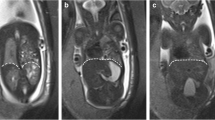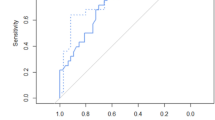Abstract
Objective
To evaluate the relationship of the liver-to-thoracic volume ratio (LiTR) by MRI with postnatal survival in foetuses with isolated congenital diaphragmatic hernia (CDH).
Methods
In 30 conservatively managed CDH foetuses and in 31 who underwent fetoscopic endoluminal tracheal occlusion (FETO), logistic regression analysis was used to investigate the effect on postnatal survival of the observed-to-expected (O/E) ratio of total foetal lung volume (TFLV), LiTR, gestational age at delivery, CDH side, intrathoracic position of the liver and, for those who underwent FETO, gestational age at FETO and occlusion period. For 19 foetuses undergoing FETO, a post-FETO MRI was available. The proportionate increase in O/E ratio of TFLV at 3–8 weeks after FETO was compared with the pre-FETO value and correlated with pre-FETO LiTR using linear regression analysis.
Results
For conservatively managed foetuses, only LiTR provided a significant prediction of postnatal survival. For foetuses undergoing FETO, LiTR and gestational age at delivery provided a significant independent prediction of postnatal survival. There was a significant inverse association between lung response and pre-FETO LiTR.
Conclusion
In foetuses with CDH with/without FETO treatment, the LiTR is predictive of postnatal survival at discharge. In foetuses treated with FETO, LiTR is predictive of post-FETO lung response.
Key Points
• Congenital diaphragmatic hernia is usually managed conservatively before surgery soon after delivery
• Fetoscopic endoluminal tracheal occlusion (FETO) has been introduced for severely affected foetuses
• In conservatively managed CDH, the liver-to-thoracic volume ratio (LiTR) predicted postnatal survival best.
• In severe CDH with prenatal FETO, LiTR also helped predict postnatal survival.
• LiTR should be integrated into the prenatal decision-making for foetuses with CDH.



Similar content being viewed by others
References
Witters I, Legius E, Moerman P et al (2001) Associated malformations and chromosomal anomalies in 42 cases of prenatally diagnosed diaphragmatic hernia. Am J Med Genet 103:278–282
Stege G, Fenton A, Jaffray B (2003) Nihilism in the 1990s: the true mortality of congenital diaphragmatic hernia. Pediatrics 112:532–535
Gallot D, Coste K, Francannet C et al (2006) Antenatal detection and impact on outcome of congenital diaphragmatic hernia: A 12-year experience in Auvergne (France). Eur J Obstet Gynecol Reprod Biol 125:202–205
Colvin J, Bower C, Dickinson J, Sokol J (2005) Outcomes of congenital diaphragmatic hernia: a population-based study in Western Australia. Pediatrics 116:356–363
Neff KW, Kilian AK, Schaible T, Schütz EM, Büsing KA (2007) Prediction of mortality and need for neonatal extracorporeal membrane oxygenation in fetuses with congenital diaphragmatic hernia: logistic regression analysis based on MRI fetal lung volume measurements. AJR Am J Roentgenol 189:1307–1311
Javid PJ, Jaksic T, Skarsgard ED, Lee S, Network CN (2004) Survival rate in congenital diaphragmatic hernia: the experience of the Canadian Neonatal Network. J Pediatr Surg 39:657–660
Jesudason EC (2002) Challenging embryological theories on congenital diaphragmatic hernia: future therapeutic implications for paediatric surgery. Ann R Coll Surg Engl 84:252–259
Kholdebarin R, Iwasiow BM, Keijzer R (2011) Pulmonary development considerations in the surgical management of congenital diaphragmatic hernia. Early Hum Dev 87:755–758
Harrison MR, Keller RL, Hawgood SB et al (2003) A randomized trial of fetal endoscopic tracheal occlusion for severe fetal congenital diaphragmatic hernia. N Engl J Med 349:1916–1924
Ruano R, Yoshizaki C, Silva M et al (2012) A randomized trial of fetal endoscopic tracheal occlusion versus postnatal management of severe isolated congenital diaphragmatic hernia. Ultrasound Obstet Gynecol 39:20–27
Jani JC, Nicolaides KH, Gratacos E et al (2009) Severe diaphragmatic hernia treated by fetal endoscopic tracheal occlusion. Ultrasound Obstet Gynecol 34:304–310
Deprest JA, Flemmer AW, Gratacos E, Nicolaides K (2009) Antenatal prediction of lung volume and in-utero treatment by fetal endoscopic tracheal occlusion in severe isolated congenital diaphragmatic hernia. Fetal Neonatal Med 14:8–13
Deprest J, Gratacos E, Nicolaides KH, FETO Task Group (2004) Fetoscopic tracheal occlusion (FETO) for severe congenital diaphragmatic hernia: evolution of a technique and preliminary results. Ultrasound Obstet Gynecol 24:121–126
Deprest J, Nicolaides K, Done’ E et al (2011) Technical aspects of fetal endoscopic tracheal occlusion for congenital diaphragmatic hernia. J Pediatr Surg 46:22–32
Cannie MM, Jani JC, De Keyzer F, Allegaert K, Dymarkowski S, Deprest J (2009) Evidence and patterns in lung response after fetal tracheal occlusion: clinical controlled study. Radiology 252:526–533
Cannie M, Jani J, Chaffiotte C et al (2008) Quantification of intrathoracic liver herniation by magnetic resonance imaging and prediction of postnatal survival in fetuses with congenital diaphragmatic hernia. Ultrasound Obstet Gynecol 32:627–632
Rypens F, Metens T, Rocourt N et al (2001) Fetal lung volume: estimation at MR imaging-initial results. Radiology 219:236–241
Cannie M, Jani J, De Keyzer F et al (2006) Fetal body volume: use at MR imaging to quantify relative lung volume in fetuses suspected of having pulmonary hypoplasia. Radiology 241:847–853
Jani JC, Nicolaides KH (2012) Fetal surgery for severe congenital diaphragmatic hernia? Ultrasound Obstet Gynecol 39:7–9
Flake AW, Crombleholme TM, Johnson MP, Howell LJ, Adzick NS (2000) Treatment of severe congenital diaphragmatic hernia by fetal tracheal occlusion: clinical experience with fifteen cases. Am J Obstet Gynecol 183:1059–1066
Jani JC, Nicolaides KH, Gratacós E, Vandecruys H, Deprest JA, FETO Task Group (2006) Fetal lung-to-head ratio in the prediction of survival in severe left-sided diaphragmatic hernia treated by fetal endoscopic tracheal occlusion (FETO). Am J Obstet Gynecol 195:1646–1650
Peralta CF, Jani JC, Van Schoubroeck D, Nicolaides KH, Deprest JA (2008) Fetal lung volume after endoscopic tracheal occlusion in the prediction of postnatal outcome. Am J Obstet Gynecol 198(60):e1–5
Author information
Authors and Affiliations
Corresponding author
Rights and permissions
About this article
Cite this article
Cannie, M.M., Cordier, AG., De Laveaucoupet, J. et al. Liver-to-thoracic volume ratio: use at MR imaging to predict postnatal survival in fetuses with isolated congenital diaphragmatic hernia with or without prenatal tracheal occlusion. Eur Radiol 23, 1299–1305 (2013). https://doi.org/10.1007/s00330-012-2709-6
Received:
Revised:
Accepted:
Published:
Issue Date:
DOI: https://doi.org/10.1007/s00330-012-2709-6




